The week at a glance
- Pallid Harrier in Cornwall
- Potential Black-eared Kite still in Powys
- Black-throated Thrushes in Glamorgan and North Yorkshire
- American Eider still in County Donegal
- Pacific Diver still on Guernsey
The chill of an old-fashioned winter failed to relinquish its deadly grip across much of the country this week — the snow continued to fall and the temperatures (in places) fell to below –20°C. "Gridlock", "treacherous" "no grit" and "true grit" were the popular buzzwords touted across the media to describe the situations many found themselves in. With such trying conditions, it wasn't too much of a surprise that, coupled with an end to the extended holiday period, there was a little bit less bird news this week, but there was still a rather impressive early January rarity salvo to contend with. Among commoner fare, the hard weather meant normally shy and secretive species were more visible than usual: Fieldfares and Redwings were popular if unfamiliar visitors to many gardens (no more reports please!), while icy conditions lead to a flood of reports of Jack Snipe, Woodcock, Bittern and Water Rail forced into the open.

Pallid Harrier, Brew Pool, Cornwall (Photo: Brian Mellow)

Pallid Harrier, Sennen, Cornwall (Photo: anon)
The identity of Cornwall's Pallid Harrier was finally confirmed this week, after the bird showed at two spots in the far west of the county during the afternoon of 10th. The bird spent time around Men-an-Tol and also just east of Sennen, and was the same individual that was seen as a "probable", back in early December, near St. Just. It appears that the bird had actually been seen a handful of times after the initial sighting and was seen again on 9th, when the question of its identity began to approach a conclusive resolution. The bird remained elusive, but showed until 13th. If accepted, this will become the second record for the county of this once-mythic creature — the Duchy's first was seen, funnily enough, around the same part of the county in March 2003.
Hopefully, for all interested parties, the 200–10 bird may replicate the well-behaved nature of the wintering juvenile in north Norfolk in 2002–03. The only slight fly in the ointment now (with all young Pallids here) is whether a hybrid has been successfully eliminated — Dick Forsman's recent paper in Birding World ensured that decent photographs will be the only real way to clinch a 100% young Pallid in the future.
Another raptor keeping itself well and truly in the news this week is the potential juvenile Black-eared Kite that remained around the feeding station at Gigrin Farm (Powys) until 11th at least. Opinion remains divided as to whether the bird is a bog-standard migrans (Black Kite) or a (presumed) vagrant lineatus. With informed comment coming down in favour of both options it confirms, once more, just how tough some forms can be (especially at this time of year). But if you haven't seen a Black-eared Kite, a trip is advised, just in case. And if all else fails, the hundreds of Red Kites will make up for it anyway.
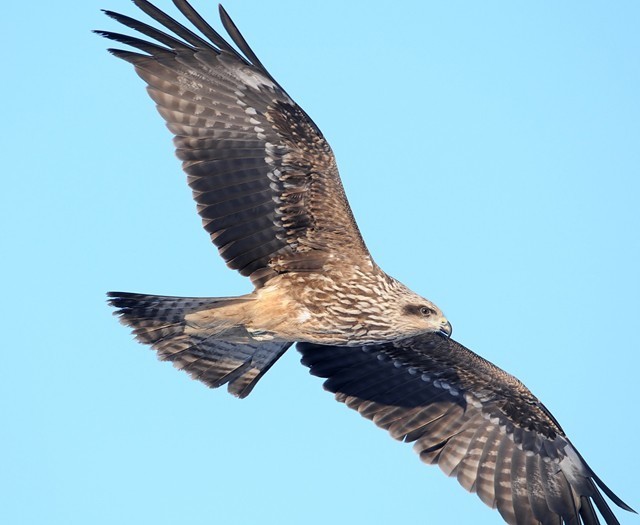
Black Kite, Gigrin Farm, Powys (Photo: Kev Joynes)
Dropping down into south Wales, a female Black-throated Thrush was a brief visitor to the Gower on the morning of 8th, seen until mid-morning only before flying off. This is the second county record, the first being the handsome adult male that wintered on the edge of Swansea in 2005–06. Another female was discovered in a private garden at Newholm near Whitby (North Yorkshire) on 10th and was still present to 13th. The news was accompanied by a nice set of photographs from the householders (and identified online). This will be the county's third record, the others coming back to back in 1989 and 1990.
The Western Palearctic's first American Eider was still present off Fanad Head (Co. Donegal) on 13th (not yet drawing much of a crowd), and in the Channel Islands the juvenile Pacific Diver remained in Grande Havre Bay (Guernsey) from 7th–9th.
Perhaps unsurprisingly, there was very little on offer in terms of seabirds this week. A Grey Phalarope was reported flying past Holme (Norfolk) on 10th and a Little Auk was seen, well inland, flying over Chelmsford (Essex) on 7th. The second of the week appeared in the more typical environs of Scarborough harbour (North Yorkshire) on 11th.
The week's only Glossy Ibis was seen in flight over Godney (Somerset) on 12th. The same county was also host to one of at least 10 Great White Egrets. Further birds continued their stays in West Sussex (heading into next-door East Sussex), Kent, Warwickshire, Lancashire and Moray, while flyovers were seen in Manchester, Dorset, Cleveland and Cambridgeshire (at Pennington Flash, Radipole Lake, Long Newton and Cambridge respectively). Two Cattle Egrets were at Shapwick Heath (Somerset) on 8th–9th and one was seen near Sennen on 10th and 13th. Two birds also remained on Jersey, at Fauvic. Around 30 Spoonbills were seen during the week, including seven at Ham Common (Dorset) on 10th (up to five more were in the county, split between Holes Bay and Lytchett Bay). Three birds remained at Courtmacsherry (Co. Cork) with another trio on the River Yealm (Devon) on 11th (with four there on 12th–13th), and there were two each for Pembrokeshire and Cheshire. The only Common Cranes of the week were three at Welney (Norfolk) on 10th.

Cattle Egret, Shapwick Heath NNR, Somerset & Bristol (Photo: Jeff Hazell)
A blue and a white Snow Goose were at Loch of Strathbeg (Aberdeenshire) on 10th, while the regular wintering bird in Argyll, at Craobh Haven, was seen on 9th. The flock of four white Snow Geese remained at Aldcliffe (Lancashire) until 10th, while in Cumbria a single white Snow Goose was at Campfield Marsh on 13th. The adult Red-breasted Goose remained in Devon to 11th, still ranging around the Exe and Clyst estuaries. On Tiree (Argyll) a Richardson's Canada Goose was at Cornaigmore on 11th and a presumed Todd's Canada Goose (form interior) was at Slimbridge (Gloucestershire) on 13th. In Norfolk, two Black Brants were seen together at Titchwell on 11th and one was still present along the north coast, at Wells. At least two adults remained on The Fleet (Dorset) during the week, another was at Cut Bridge (Hampshire) and a single bird was again at Dungarvan (Co. Waterford) on 10th.
On Scilly, the drake Black Duck moved across to St. Mary's on 8th, flying towards Lower Moors with Mallards. At least one drake Green-winged Teal was in Hampshire this week, at Langstone Harbour on 9th then Hayling Island from 10th–11th. Five others were mentioned, including familiar birds at Eyebrook Reservoir (Leicestershire) and Ballycarry, Larne Lough (Co. Antrim) and new arrivals at Llyn Coron (Anglesey) on 11th, and at Rubha Ardvule, South Uist (Outer Hebrides) on 12th. On the Scottish mainland, at Tain, a Green-winged Teal was seen on 12th and is likely to be the returning bird from last winter.
The drake Lesser Scaup was back at Cardiff Bay Wetlands (Glamorgan) on 9th–12th, while one youngster remained on La Grande Mere (Guernsey). Five Ring-necked Ducks were reported this week, including two in West Yorkshire, drakes seen at Horbury and again at Pugney's CP, both on 12th. Further drakes lingered at Porth Reservoir (Cornwall), Fleetwood then Preesall (Lancashire) and Macroom (Co. Cork). A young female Ferruginous Duck was at Wraysbury GPs (Berkshire) on 7th–8th (and reported again on 12th) and the drake remained at Craigavon Balancing Lakes (Co. Armagh) until 12th.
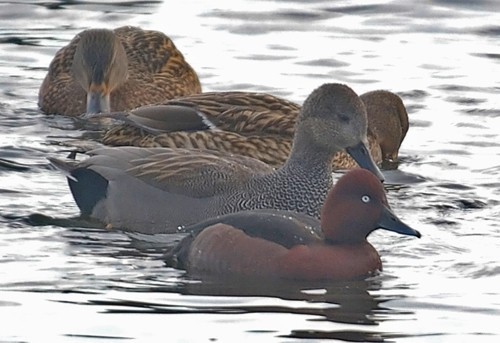
Ferruginous Duck, Craigavon Balancing Lakes, Armagh (Photo: Derek Charles)
A drake Surf Scoter was seen off Llanddulas (Conwy) on 7th and another drake was again off Ruddon's Point (Fife) on 8th. The returning wintering female was still off Dawlish Warren (Devon) until 11th at least and the female was still in Hough Bay, Tiree as well.
In north Cornwall, a white Gyrfalcon (or Gyr-type falcon) was seen (and photographed) on the cliffs near Widemouth Bay on 7th. A Rough-legged Buzzard was on mainland Orkney on the same date and appeared again on 12th. Another remained around the Fritton and Chedgrave Marshes (Norfolk) to 8th at least, with a further Norfolk bird reported flying over the A11 near Wymondham on 9th. In Perth & Kinross, the three released White-tailed Eagles lingered around Vane Farm, with another still at Loch of Strathbeg.

Gyr Falcon, Widemouth Bay, Cornwall (Photo: Maurice Pankhurst)
Late news from Pembrokeshire, for 2nd January, was of a Snowy Owl on Cilau Moor for 25 early-morning minutes before it departed to who-knows-where. Another report of a Snowy Owl came from fields near the M62 in East Yorkshire on 12th. A probable Dark-breasted Barn Owl was taken in to care at Newbiggin-by-the-Sea (Northumberland) on 9th (though any guttata candidate is now likely to fall foul of the stringent identification criteria set in place by those chaps over in BBRC-land).
The first-winter Long-billed Dowitcher remained at Loch Gruinart (Argyll) until 7th, and in Wales a Long-billed Dowitcher was at Connah's Quay (Clwyd) on 12th (one was seen here on four October dates last year). The Baird's Sandpiper at Barns Ness (Lothian) was still present to 11th at least, and in Devon the first-winter Spotted Sandpiper was still at Topsham on 7th–12th.
A possible second-winter Kumlien's Gull was reported from Carcroft (South Yorkshire) on 11th and a confirmed second-winter was near Irthlingborough (Northamptonshire) on 13th. The week's total of 22 Iceland Gulls included five at Stromness (Orkney) on 10th, and at least 27 Glaucous Gulls were seen, widely spread from Cornwall to Shetland.
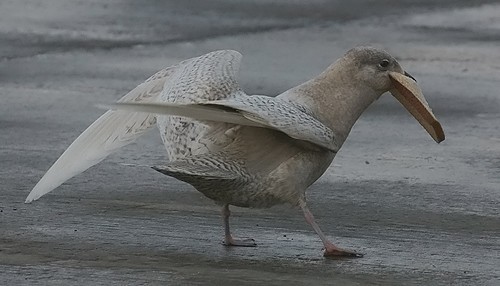
Iceland Gull, Greencastle, Donegal (Photo: Derek Charles)

Glaucous Gull, Gainsborough, Lincolnshire (Photo: Dean Nicholson)
Caspian Gulls were again well represented: at least 30 birds were found, including four at Dartford (Kent) on 10th. Also on 10th, three birds were seen at Blackborough End tip (Norfolk) and the previous day saw three at Fen Drayton Lakes (Cambridgeshire). Three different birds were noted at Rainham Marshes (London) during the week. Most others were seen in Midland counties, although the adult was still in Hampshire and Lancashire scored its second in a week when one appeared for several days at Seaforth NR until 11th (there have been fewer than ten previous records in the county).
Ireland beat the UK 7–5 this week in terms of Ring-billed Gulls. There were two each for Antrim and Dublin (including a first-winter at Dun Laoghaire on 10th), with singles in Derry, Galway and Limerick. As well as regular birds in Hampshire, Essex and Argyll, an adult was at Seaforth on 8th–9th and the second-winter was again at Strathclyde Loch on 10th and 12th. Back in Ireland, the adult Forster's Tern was again off Mutton Island (near Galway's Nimmo's Pier) on 11th.

Ring-billed Gull, Strathclyde Loch, Clyde (Photo: Keith Hoey)
In Cork, a Black-bellied Dipper was reported on the River Argideen near Timoleague on 8th. The Richard's Pipit remained around Sennen until 7th, with it (or another) at Land's End on 11th, and another was found at Ynyslas (Ceredigion) on 9th. On the Isle of Wight, the wintering Hoopoe has been seen again recently near Brighstone. Despite the continuing blast of cold continental air, Waxwings remained pretty scarce: around 40 were seen, including a flock of 20 at Beccles (Suffolk) on 7th–8th.
Reported Great Grey Shrikes fell to just three confirmed birds this week: one lingered at Fenn's Moss (Clwyd) to 10th, one was found at Grandborough (Warwickshire) on 8th, remaining to 11th, and in South Yorkshire another was at Thorne Moors on 12th (one was present here for several days in October, and again, for a day, in November). A probable Great Grey Shrike was near Carlton Colville (Suffolk) on 13th.
In London, a Serin was still at Rainham Marshes until 12th at least, while in Kent a Penduline Tit was at Dungeness on 11th and 13th (two birds were present there to mid-December). Up in Highland, the Little Bunting remained at Dunnet Bay for another week, still present on 13th.

Jack Snipe, Budleigh Salterton, Devon (Photo: Cream Tea Birder)
Photo of the Week

Fieldfare, Hartlebury, Worcestershire (Photo:
Mark Hancox)
A prolonged period of colder-than-usual weather in the UK is driving huge numbers of birds from the open countryside into more populated areas in a desperate bid for survival. In particular, countless people are seeing Redwings and Fieldfares in their gardens for the first time. Some of these normally shy winter visitors from Scandinavia are even starting to visit bird feeders. The increased approachability of these thrushes has not gone unnoticed by bird photographers, who have submitted around 200 photos of them this week alone. The standard of these images has been very high and so only a special image could stand out from the crowd. In fact, Worcestershire-based bird photographer Mark Hancox sent us two such images — both featuring Fieldfares — that we were hard pressed to choose between. In the end, our pick was the gorgeous portrait shot of the bird alighting on a branch, tail fully fanned. A simple composition emphasizes the dramatic pose and strong diagonal lines lead the eye around the image: along the branch, down from the tail to the head, along the gaze of the bird and finally along the wing and leg. The striking plumage is beautifully lit, especially by the reflected up-lighting from the snow below. A perfect background to complement the plumage colours rounds off a highly aesthetic and evocative image.
Other notable photos
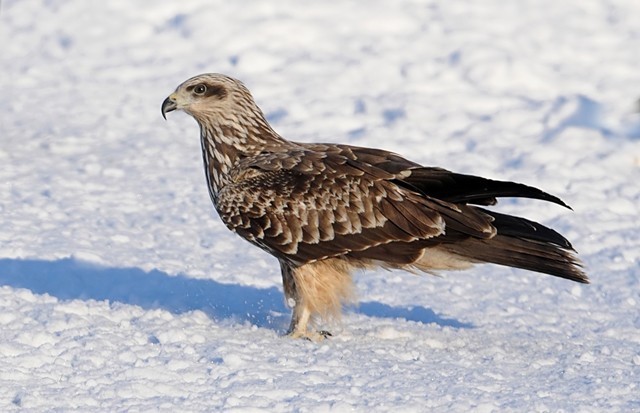
Black Kite, Gigrin Farm, Powys (Photo:
Kev Joynes)

Red Kite, Gigrin Farm, Powys (Photo:
Kev Joynes)

Brambling, undisclosed site, Shropshire (Photo:
John Fielding)

European Stonechat, undisclosed site, Lancashire (Photo:
Brian Rafferty)

Goldfinch, undisclosed site, Lancashire (Photo:
Brian Rafferty)

Common Buzzard, Attlebridge, Norfolk (Photo:
David Whistlecraft)

Starling, Kensington Gardens, Greater London (Photo:
Fraser Simpson)

White-tailed Eagle, undisclosed site, Argyll (Photo:
Jimmy MacDonald.)

European Bee-eater, Hungary (Photo:
Eduardo Balogh)

Woodcock, St. Mary's Island, Northumberland (Photo:
Nigel Tinlin)

Common Kingfisher, Alphington, Devon (Photo:
Charlie Fleming)

Hawfinch, Hungary (Photo:
Eduardo Balogh)
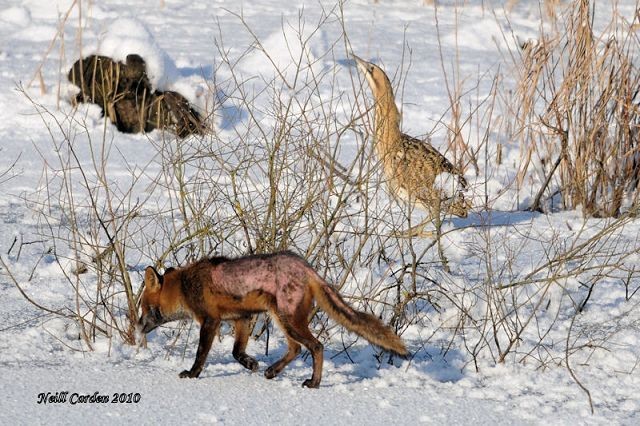
Bittern, Moore NR, Cheshire (Photo:
Neill Carden)

Pheasant, East Walton, Norfolk (Photo:
Stephen Durrant)

Yellowhammer, undisclosed site, Staffordshire (Photo:
Steve Round)
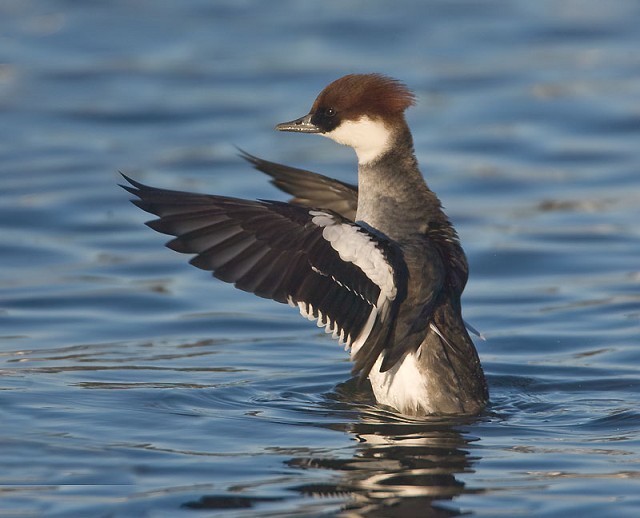
Smew, Linlithgow Loch, Lothian (Photo:
John Anderson)

Cetti's Warbler, Chew Valley Lake, Somerset & Bristol (Photo:
Gary Thoburn)

Water Rail, Budleigh Salterton, Devon (Photo:
Cream Tea Birder)

